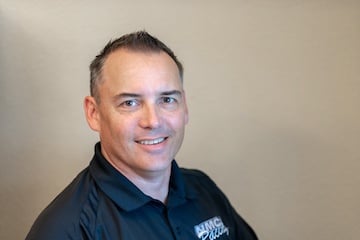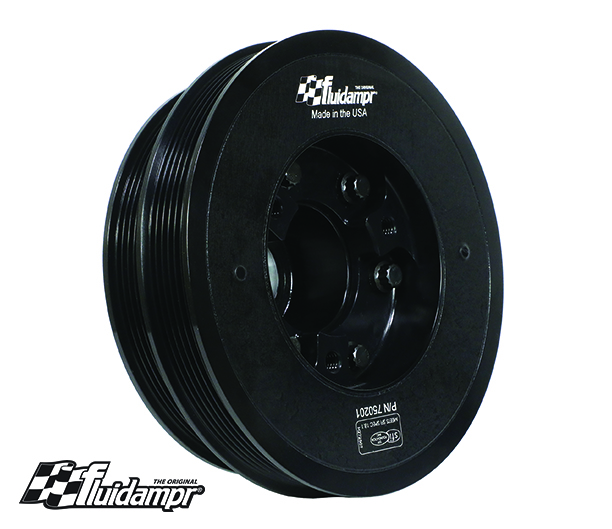Despite coming to market as solely a truck-based powerplant, Ford’s 7.3-liter pushrod engine dubbed internally as “Godzilla” has been the next big thing for performance enthusiasts who are looking to build something unique, take advantage of the engine’s massive cubic-inch displacement, or both. As enthusiasts became familiar with the engine platform, the aftermarket responded with swap components and performance upgrades. Fluidampr is one such company, and now offers a high-performance harmonic damper designed specifically for the Godzilla engine.
Damper Or Balancer?
Harmonic balancer and harmonic damper are often used interchangeably by enthusiasts, but there is one thing that sets them apart. Older engine platforms that have rotating assemblies that are externally balanced utilize a harmonic balancer. This is when you find a harmonic damper that also is weighted, just as with a flywheel/flexplate, to an engine. A harmonic damper does not have the added weight, as the rotating assembly is internally balanced, and the dampers’ only function is to manage the vibrations that occur as the rotating assembly rotates through its power cycle.
Bad Vibrations
It’s no secret that engines vibrate. There are moving parts inside and the side effect of that is vibration. Engines will produce rotational vibrations, axial vibrations, and torsional vibrations, and it’s the last one for which harmonic dampers are employed.

This graphic illustrates the torsional vibration force (green area) on a crankshaft as it goes through its cycle.
Torsional vibrations are generated by the end-to-end twisting of the crankshaft due to the combustion occurring during engine operation. These vibrations are dynamic, as well, and change throughout the RPM range of an engine. There is much more to this subject that we will get into here, but Fluidampr has plenty of great information that delves deeper into this on its website.
Viscous vs. Elastomer Damper
Different damper manufacturers have different approaches to quelling torsional vibrations. The OEM standard has been the elastomer damper, where a hub is bolted to the end of the crankshaft and an elastomer material (usually rubber) is applied to the outer face of the hub. This is used to attach a steel inertia ring that resonates when the vibrations occur. As it resonates, it reduces the harmonics caused by the torsional vibrations.
Fluidampr products are known as viscous dampers. In this design, the hub encases the inertia ring, which is suspended in a viscous silicone fluid.

Fluidampr products feature a sealed design that will last the life of your engine and quite possibly beyond.
“As the engine is running, the inertia ring inside is going in and out of phase, so the inertia ring is changing with the harmonics created by the engine,” Fluidampr’s Nick Orefice explains. “In theory, it’s self-tuning all the time. It doesn’t matter if it’s a stock or a race engine.”
High-Performance Dampers
Engine designers and automobile manufacturers work to reduce noise, vibration, and harshness or NVH, in vehicles, and harmonic dampers play a part in this. Like all factory engine components, though, they are designed to work in a particular application and performance envelope. When those parameters change, such as when someone modifies the engine or driveline, the damper may not be able to react properly and provide adequate damping. This is where companies like Fluidampr come in and offer products that not only provide improved performance and damping characteristics.
Just as wider, sticky tires do the same thing as skinny stock tires might, but offer greater performance over stock tire when changes to the vehicle may push the limits of traction, high-performance, aftermarket dampers such those from Fluidampr work in a wider operating range. The company knows changes to a driveline in the pursuit of performance happen often throughout an enthusiast’s ownership of a vehicle, and the vibrations created by the engine and the changes to the driveline will change the nature of the vibrations with each modification.

The Fluidampr for Ford’s Godzilla 7.3-liter engine features all-steel design with a hardened steel hub instead of a normal high-strength steel hub, and also has a 3.2-inch bolt circle to run an accessory drive for a fuel pump, water pump, or dry sump.
Obviously, original equipment dampers aren’t best suited to a performance environment, and even with high-performance elastomer dampers, there is a bit of room for improvement, depending on the application.
“A stock damper is made to just target the most harmful vibrations and work in a very narrow band to take the harshness off,” says Orefice.
If the vehicle is going to be daily-driven and subjected to sustained high temperatures under the hood, that heat can ultimately affect the long-term durability of elastomer dampers. This is where Fluidampr’s viscous damper excels, as the inertia ring and fluid are encased in the damper itself. Because of this, Fluidampr products may be the last damper you have to buy for your engine.
The Fluidampr
The folks at Fluidampr obviously feel the viscous-style damper is the best way to quell the torsional vibrations while providing a long-lasting component. The latter is a rarity in any product, let alone one designed for high-performance engines.
Fluidamprs are manufactured in the USA with USA-based materials, and each one is SFI-certified, which ensures a high degree of safety as well as compatibility with racing sanction class rules.
“A Fluidampr never needs to be rebuilt or retuned,” Orefice explained. “Being a viscous damper, the inertia ring is inside in a bed of fluid. In this case a silicone-based proprietary substance that doesn’t degrade. It is hermetically sealed with a laser weld and 100-percent nitrogen pressure-tested to ensure no leakage before packaging. There will never be enough miles or wear to cause it to go bad. Unless our damper gets in a fire or loses its press-fit on the crank snout or gets dropped or damaged, it will never need to be replaced.
“Our damper has a rotating weight, but you have to look at it differently than an elastomer damper. In a viscous damper with the technology of the inertia ring being suspended, it self-centers, levitates, and the crankshaft only feels about 2/3rds of the weight. For example, if the damper weighs 18 pounds, the crank only feels 12 pounds of it while the engine is running,” Orefice goes on to explain.
Improving Engine Performance
If you checkout Fluidampr’s website, you’ll see that in some applications, using a Fluidampr can actually improve engine performance, freeing up lost horsepower and torque. Some applications have shown increases of 10-plus horsepower, according to Fluidampr.
“Our engine dyno testing is done at an outside location, from OE race teams to grassroots engine builders,” notes Orefice. “By reducing or removing the harmonics, it releases horsepower and torque that was otherwise not available.” Orefice also told us that improving the harmonic reduction usually shows an improvement in shifting in manual transmission vehicles, as well as reducing wear on other critical components such as bearings and oil pump gears.
Godzilla Attacks!
Like many companies, Fluidampr now offers products for Ford’s Godzilla 7.3-liter engine, and some time ago, that kicked off with a call from noted engine tuner and racer, Paul Svinicki of Paul’s High Performance.

Having used Fluidampr products since the 90s, Paul’s High Performance founder Paul Svinicki turned to Fluidampr when it came time to kick off his Godzilla 7.3 engine swap and test.
“Paul gave us a call one day and introduced himself,” Orefice says.” He told us what he had going on and his intentions. We had just wrapped up the Fluidampr for the GM L8T engine and had great success. It was a no-brainer when Paul contacted us.”
Svinicki has used Fluidamprs since “way back in the day” for racing.
“We used the Fluidampr back then and still have a race motor with one on it from the late-to-mid ’90s,” Svinicki tells us. “We always had good luck with them and made a cold call and they said ‘Yeah, whatever you need.’”
“Paul supplied us with an OE part and great information,” Orefice notes. “We had a bit of a slow start, but it was one of the fastest damper projects from start to finish. Paul did testing for us and is running it on his Cobra Jet.
“We knew they were going to be going at it with a lot of power. It’s an all-steel design with a hardened steel hub instead of a normal high-strength steel hub, and also has a 3.2-inch bolt circle to run an accessory drive for a fuel pump, water pump, or dry sump — it’s ready for a mandrel,” Orefice says.

Paul’s High Performance has a long history of pushing the envelope of performance with new Ford products, and it’s latest test is the Godzilla-swapped Ford Performance Cobra Jet that runs solidly in the 8s.
Svinicki originally swapped a stock Godzilla engine into his Cobra Jet.
“The engine is very robust, even with many stock components,” Svinicki tells us. “With 400 horsepower of nitrous, the Cobra Jet went 8.89 at 146 with a production engine using stock, cast manifolds.”
While Fluidampr was working on its damper for the Godzilla engine, Svinicki was working to aid development of other internal engine components, as he planned to improve the horsepower and torque of the monster motor. “The camshaft we had before was a custom re-grind, and now we have a specific cam for nitrous and for 7,200 rpm,” Svinicki explains. “The new engine went 8.80 at 148 mph with 200 horsepower less nitrous and we haven’t leaned on it.”
The Fluidampr for Ford’s Godzilla engine retains the stock dimensions and is within a couple of ounces of the stock weight, but it is SFI-approved and, of course, dyno testing alongside torsional analysis showed the harmonic reduction is much improved.
Svinicki’s new engine produces 1,150 horsepower, with 600 of it coming by way of a dry nitrous system, and the Fluidampr continues to work well in that performance envelope.
“Right now, we have over 125 passes and everything is staying exactly where it was,” Svinicki says.
“We overbuild our products so the end user doesn’t run into issues,” Orefice tells us. “They need to catch up to our limits.” Currently, Fluidampr’s Godzilla damper (P/N: 750201) retails for around $630. If you’re planning a Godzilla swap and exploring its performance potential, you might want to check out Fluidampr’s solution for harmonic damping.






















